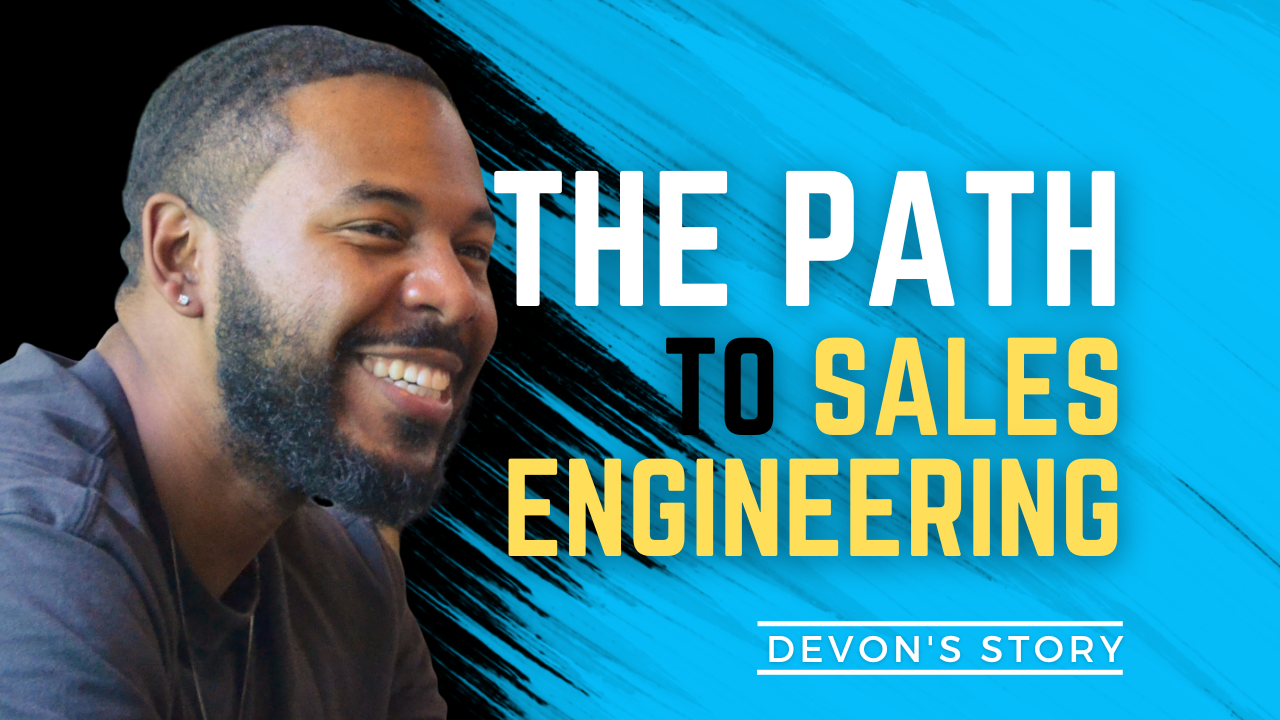The Real Path to Sales Engineering: Devon’s Story from Manufacturing to Lead SE
Learn how Devon transitioned from manufacturing engineer to lead sales engineer and what it actually takes to break into this high-trust, high-impact tech role.


INTRO
Sales engineering is one of the most misunderstood jobs in tech. It pays well, blends technical and communication skills, and gives you a front-row seat to big customer decisions. But despite what bootcamps and LinkedIn posts might say, it’s not an entry-level role.
This post walks through the exact journey Devon Montgomery took from a manufacturing floor in Japan to becoming a lead sales engineer at a fast-growing tech company. If you're trying to break into SE, this is the real playbook.
WHAT YOU’LL LEARN
- Why sales engineering is not a shortcut into tech
- What hiring managers actually look for in SE candidates
- How Devon used an SDR role to open the right doors
- How to navigate rejection, ego, and slow progress
- What to focus on if you're serious about making the leap
CONTEXT: WHY THIS MATTERS
There’s a growing narrative online that sales engineering is an easy on-ramp into tech. But most people who chase that path never land the role. The reason is simple.
Sales engineers aren't just demoing software. They're helping enterprise buyers solve complex problems, often across multiple stakeholders and departments. That takes trust, product knowledge, and business intuition.
It's very rare to see Sales Engineering positions that are truly 'entry level'. But at the same time, it's one of the most in demand roles in tech. So how do you get there?
HOW DEVON BROKE INTO SALES ENGINEERING
FROM MANUFACTURING TO CUSTOMER-FACING TECH
Devon started his career as a manufacturing engineer working in Japan. He handled quality issues, coordinated with project managers from Ford, and built systems that improved production.
But over time, he realized he didn’t want to sit behind the scenes forever. He wanted to work directly with customers and solve problems in real-time. That interest is what first led him to sales engineering.
STRATEGY: START IN SALES, BUT PLAN YOUR MOVE
Devon didn’t try to skip ahead. He took a job as an SDR and was completely honest with leadership about his goals.
From day one, he told his manager:
“I have a technical background. I’ll hit my SDR targets, but I’m aiming to become a sales engineer.”
Instead of waiting around, Devon introduced himself to one of the senior SEs and asked for help. That conversation became a mentorship. His mentor gave him a roadmap to follow, including what skills to build, which materials to study, and how to prepare for internal opportunities over the next 12-18 months.
He followed that plan while continuing to perform in his SDR role, making sure he earned the respect of his peers and managers.
WHY SDR EXPERIENCE BUILDS STRONGER SALES ENGINEERS
Devon didn’t love cold calling. At times he even hated it. But that experience gave him something technical roles often lack—an understanding of how buyers think.
Being an SDR taught him how to ask questions that get to the root of the problem. He learned how to speak with confidence, navigate tough conversations, and listen for what people really care about.
“A good demo is just a great conversation. SDR taught me how to have those.”
Most SEs who skip the front-end of the sales process struggle later. They can explain the product, but they can’t connect it to the buyer’s goals. Devon avoided that gap by doing the hard reps first.
PATIENCE, HUMILITY, AND A LONG-TERM VIEW
Devon originally thought it would take six to eight months to land an SE role. It took almost two years.
Along the way, he turned down a promotion in engineering, lived in a bunk bed in the Bay Area, and questioned if the move into sales was a mistake. But he stayed focused.
He stayed close to leadership, kept asking questions, and never stopped learning. Eventually, he earned a shot. First at Twilio, and later as a lead SE at Caliber.
WHAT HIRING MANAGERS LOOK FOR IN SALES ENGINEERS
It’s not about how well you can demo the product. It’s about how well you can guide the customer.
Sales engineering interviews often center around one question:
Does this person make me feel confident putting them in front of a skeptical customer?
That means you need to show more than technical knowledge. You need to prove that you understand the buyer’s world.
- What business problems do they care about?
- What’s at stake if they choose the wrong tool?
- Can you ask the right questions to uncover those problems?
- How does your tool fit in the context of the entire organizations tech stack?
- Will you follow through and help them win the deal internally?
Devon didn’t get promoted because he knew the product better than everyone else. He earned the role by showing he could be trusted in high-stakes conversations.
CAREER PATHS AFTER SALES ENGINEERING
Once you're in, there are a lot of ways to grow. Devon shared a few common directions:
- Senior SE to Lead SE to Principal SE
- SE Manager to Director of Solutions Engineering
- Product management, customer success, or technical consulting
You can lean into management, stay hands-on, or even pivot toward strategy. In Devon’s case, he’s focused on staying close to the field, mentoring new SEs, and continuing to sharpen his skills in high-impact deals. Check out the full length conversation to learn the ins and outs!
FAQ
Q: Can I become a Sales Engineer without prior tech experience?
A: It’s difficult. Most SEs have either hands-on technical experience or prior sales experience with technical products.
Q: How long does it take to move from SDR to SE?
A: Expect 18 to 24 months. Devon’s transition took nearly two years, even with strong mentorship and clear intent.
Q: Is Sales Engineering a good career path?
A: Yes, if you enjoy problem solving and communication. It pays well and builds skills that translate into many other roles across tech.
Q: What makes a strong SE candidate stand out?
A: The best candidates can explain complex ideas in simple language. They know how to connect features to business outcomes and can lead confident conversations with decision makers.
Q: What’s the best first step toward becoming an SE?
A: Start in a role that gives you customer exposure, like SDR or solutions consultant. Find a mentor, study your product deeply, and learn how to ask great questions.
→ If you're serious about breaking into tech—whether as an SDR or a future Sales Engineer—join our free Tech Sales community and get real coaching from people who’ve done it.
TL;DR
- Sales engineering requires business acumen and technical depth
- Devon broke in through an SDR role and earned trust internally
- Cold calling taught him how to run better demos and ask better questions
- Hiring managers look for trust, clarity, and problem-solving skills
- The role has long-term upside, but the path is slow and requires patience
.svg)
.svg)
.svg)
.svg)
.svg)
.svg)

.png)

.png)

.svg)








